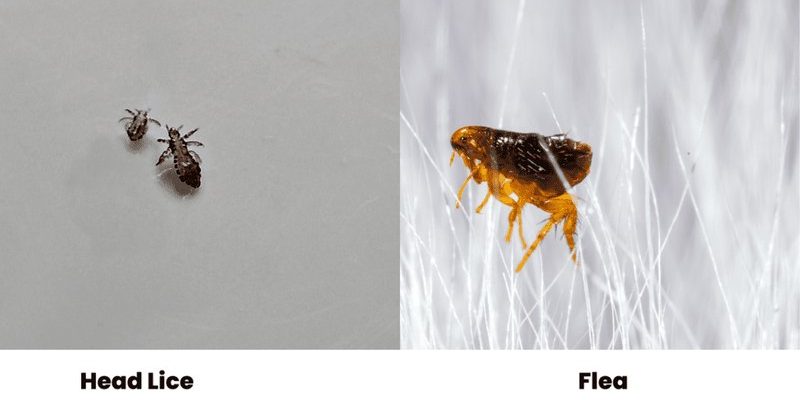
So, let’s dive in. Imagine you’re looking at a miniature jumping bean in your living room. Is it a flea, or could it be a similar insect like a tick or a bed bug? Knowing what you’re dealing with can help you take the right approach to manage the problem. This article breaks down the differences, making it easier for you to identify these critters and figure out how to deal with them effectively.
What Are Fleas?
Fleas are small, wingless insects that belong to the order Siphonaptera. These pests are best known for their incredible jumping ability, which can be up to 200 times their body length. Yes, if a flea were the size of a human, it could jump as far as a football field! This impressive skill helps them navigate through fur and find their next meal—blood. Fleas are primarily parasites, feeding on the blood of mammals and birds, including our beloved pets.
Flea bites can cause intense itching, skin irritation, and in some cases, allergic reactions. These pests are most commonly found in homes with pets. If you notice your dog or cat scratching more than usual, it might be time to check for fleas. Getting rid of fleas can be challenging since they reproduce quickly, and their eggs can lie dormant for long periods.
How Do Fleas Compare to Ticks?
Now, let’s look at ticks. Ticks are also parasitic but belong to a different category—the arachnids, meaning they’re more closely related to spiders than insects. Ticks are often seen clinging to animals or humans, waiting to latch on for a meal. Unlike fleas, ticks don’t jump; they crawl and attach to their hosts.
While fleas tend to cause more irritation through quick bites, ticks can pose a greater health risk. They can transmit serious diseases like Lyme disease and Rocky Mountain spotted fever. So, if you find a tick on your pet or yourself, it’s important to remove it properly and watch for any signs of illness.
Recognizing Bed Bugs vs. Fleas
Many people confuse bed bugs with fleas, especially since both can cause itching and discomfort. Bed bugs, however, have a different lifestyle. Bed bugs are flat, oval-shaped insects that hide in cracks, crevices, or the seams of mattresses during the day and come out at night to feed on human blood.
Fleas prefer to live on hair-covered animals, while bed bugs prefer human habitats. If you’re waking up with unexplained bites in a straight line or cluster, it’s likely bed bugs. On the other hand, if your pet is excessively scratching, it’s probably fleas.
Fleas vs. Lice
Another insect that might come to mind when thinking about fleas is lice. Both are parasites and feed on the blood of their hosts, but they have distinct differences. Lice are specific to humans and are primarily found on the scalp, body, or in pubic areas. They’re not known for jumping; instead, they crawl.
Fleas can jump and are more versatile regarding their hosts, affecting various animals. While both cause itching and discomfort, lice infestations often require different treatments, such as medicated shampoos or lotions, whereas fleas are often managed with topical treatments or flea collars for pets.
Identifying Fleas vs. Other Small Insects
You might also encounter other small insects that can be mistaken for fleas, such as ants or small beetles. While these aren’t parasites, some of them can invade your home and create annoyance. Ants might not bite like fleas, but they can infest your pantry and other areas looking for food.
To identify whether you’re dealing with fleas or another insect, look for signs like jumping behavior or the presence of flea dirt (tiny black specks of flea feces). Knowing the differences can help you determine the right treatment options.
Why Understanding Fleas and Similar Insects Matters
Taking the time to understand the distinctions between fleas and similar insects is important for several reasons. First, identifying the right pest can save you time and money. Treatments for fleas vary significantly from those needed for bed bugs or ticks.
Second, understanding the biology and behavior of these insects can help you take preventative measures. If you know that fleas thrive in certain conditions (like warm, humid environments), you can make your home less inviting to them. Regular cleaning, vacuuming, and treating pets can make a huge difference.
Lastly, proper identification can help in avoiding potential health risks. Knowing whether you’re dealing with fleas, ticks, or something else can guide you in seeking advice from pest control experts or medical professionals if needed.
In conclusion, while fleas can be pesky little vampires, understanding how they stack up against similar insects like ticks, bed bugs, and lice can empower you to take informed action. Whether you end up needing a professional exterminator or a simple over-the-counter solution, being able to recognize the specific insect is key.
So, the next time you spot a bug hopping around your home, take a moment to identify it. Armed with knowledge, you’ll be better equipped to tackle the problem and keep your space pest-free. No one deserves to put up with the annoyance of fleas or their lookalikes—knowledge is your best defense!

